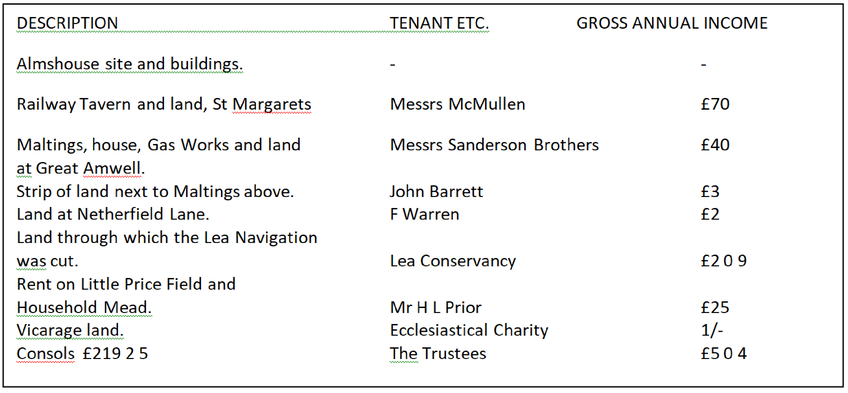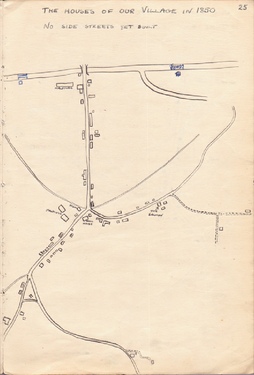From 1676 to 1824 the manor and the patronage of the church were both in the hands of the Fielde family and the list of Vicars shows that two members were also Vicars of the parish. Apart from the cutting of the Lea Navigation channel about 1730 which would open the river to increased use and thus benefit the traders here, little is known of this century . An amusing sidelight on how thieves were dealt with is given by the court order that a man named Hollingsworth should be “whipped from bridge to bridge” –presumably the length of the high street, a punishment which if carried out with energy by the villagers should have proved very effective. During these peaceful days farming and malting would be able to develop to the good of the inhabitants.
Much argument is caused even today about the spelling of Cappell or Chapel Lane, but the fact that the Clockhouse , in addition to being a school on weekdays , was used as a chapel (ie a small substitute for a church, not a chapel as we understand it today) on Sundays would seem to explain, this the original name being Chapel which became corrupted to Cappell. The building of the present chapel later on would further complicate things. If this is so, it upsets the reason for the change back to Cappell recently which was that this was the original spelling.
With the industrial revolution , the village began to grow and much of the rest of its story deals with its growth to modern conditions. The maps on pages 25, 26 and 27 try to show this growth. With growth to decay inevitably walks and one proof of this is to be found in the fate of Rye House castle for it was used until 1834 as the local workhouse. It is to be hoped it is only a coincidence that a few years later the new owner of the Rye found it necessary to remake the toll road. Before coming to this man (Sir Charles Booth) another monument in St James’s church shows the link between us and national endeavours, for it is to Sir Felix Booth whose family occupied Stansteadbury for some years. He financed at his entire expense the 1829 expedition to try to find a NW passage around America .
Also before the toll road needed its repairs, the progress of transport brought a
red letter year to the village. In 1843 the railway line from Broxbourne to Hertford
was opened and crowds watched excitedly for the passing of the first “Iron Tram”.
Rye House had by then become a resort for fishermen and day trippers from London
and now trains helped coaches to swell their numbers. The first timetable for the
new line shows trains leaving Hertford at 7.30, 8.30,9.40 and 11.40am and 6:40 PM
on Sundays. Fares were first class 5/-
In 1863 the “Buntingford, Hadham and Ware” railway was opened and operated at first
by a private company. It provided four trains in each direction, leaving Buntingford
at 7.35 and 10:25 AM and 4.50 and 7:45 PM and leaving St Margaret’s at 9:10 AM and
12.10, 6.10 and 8:45 PM. Though it is by no means certain, it seems likely that
for its first 20 years our station consisted of the very small platform still to
be seen adjoining the Station-
The rapid development of those days is shown in the great increase in value of the Manor andin its breakup in the years 1860 to 1867. Its value in 1842 had been placed at £29,000 and 25 years later it was sold piecemeal for £75,000. With this sale the manor lost its identity for the first time since it was first mentioned in the Domesday Book, an event which marks the beginning of a completely new age. Mr Teale bought Rye Manor in 1860 and encouraged its popularity with trippers by purchasing The Great Bed of Ware to put on show there. Sir Charles Booth bought Netherfield Estate while Mr. TF Buxton bought the rest of the Manor and changed history by building Easneye House which superseded Stansteadbury as the Manor House. The latter house was meanwhile sold to Captain Trower and it still remains in the hands of the family.
With this interest in the development of property, it is appropriate to look at some of the bigger houses of the area .
Newlands stands on the site of an ancient estate , originally called Newgatelands and Newgate Wood also takes its name from this. Netherfield, built about 1830, stands on the site of two older houses and the name Nether is Saxon for neither the one nor the other ie common to all which accounts for the Common Land we read of in Domesday Book.
Stansteadbury, already mentioned as being much added to, was at one time in the first half of the 19th century used as a Hydropathic Hospital, the water of its spring and our healthy air once again attracting the attention of seekers after health.
Finally with the building of Easneye in 1869 the park enclosed over 500 years previously, saw its first occupiers.
In this same year the present school was built under the direction of the same architect,
a Mr. Waterhouse, on land given by Mr. Buxton who also subscribed very generously
to the cost of its construction. It is interesting to note that the school is still
the property of Mr. Buxton to whom the County Council pay 1/-
By the beginning of this century the Pied Bull was enjoying its most famous days with stage coaches bringing crowds at weekends. The Mill Stream was a busy piece of water with fishing boats on hire from the Pied Bull bank at weekends and a public wharf at the rear of the Mill at which coal for the village was unloaded, the coal carts reaching the wharf along the land between No 1 Roydon Road and the Mill. Many is the photograph of happy scenes at the Pied Bull which can still be produced by old inhabitants, but the coming of the Motorcar took people further afield so that now a trip to Southend corresponds to a 1900 trip to these parts.
Returning to the school we find that for some years after its opening only Girls
and Infants were admitted, but in 1872 boys from the Clockhouseschool began to seek
admission. Lavatories and playground accommodation were not suitable, however, and
it was not until 1879 that the Clockhouse ceased to be a school. Meanwhile the Girls
school at St Margaret’s had closed in 1876, ten girls transferring to our school.
During the first 10 years of the school no fewer than seven Head Teachers came and
went, yet since then only three Headmasters have, so far, shared 70 years. The original
building consisted of the three large rooms only, the two smaller ones having been
added in 1891 and 1895. The school was consecrated for use as a chapel on Sundays
and a seat in the big room cost 12/-
Though the Countess of Huntingdon’s chapel had been built in 1874 (and licensed for marriages in 1880) it did not have a large meeting room and a frequent note in school log books till as late as 1900 says that the “Dissenters Tea party” was held in the big room. The use of this term for chapel people reflects the bitterness of religious disputes. Apparently the church too had its internal troubles for the Church Wardens book shows an expense of £37 10 0 for the prosecution of Robert Hogan in 1832 for libel but whom he libelled is not stated.
Even when, in 1881, Mr. TF Buxton provided most of the cost and labour and much of the materials for the erection of St Andrew’s church, a religious topic became the centre of strife, for he was accused of building the church solely for his own benefit, his house being the furthest from the old church. Quite possibly the fear that St James’s would be neglected and allowed to decay was behind this attack and it is therefore good to see that this is not so , services being held there regularly. In 1905, the Church Wardens book records that the Buxton family planned to give a peal of bells for the church to commemorate sixty years of married life of Mr. T F and Mrs R Buxton but unfortunately Mrs Buxton died too soon, so the tower has only its four bells which are chimed, not rung.
The Easneye Estate in its early days made a large contribution to the building of houses in the village as is shown by the number of strong red brick houses typical of the estate even today which can be counted.
With the encroachment of modern ways, two more signs of old times disappeared. In 1886 the last tolls were collected at Thele Bridge and at about the same date the ancient tythe barn opposite the vicarage was demolished. The sexton’s house also became uninhabitable, as gradually, did other old houses, including the toll cottage at the St James’ Church end of the road.
Next to feel the effect of changing ways was the Baesh charity for in 1911 it was
taken over by the Charity Commissioners and brought up to date by the following
alterations in its terms:-
The trusteeship too was altered , the Lord of the Manor, if of age, was appointed a trustee ex officio; four others were to be chosen by the parish council after which these five were to choose two other residents or persons trading in the village, to complete the trustees.
The properties of the charity having undergone many changes since 1636, a list of the sources of revenue was drawn up, a copy of which follows.

Since then all except the two Almshouses themselves, the Vicarage land and the £25 rent charge have been realized and the money invested in Trustee Stock. When the Clockhouse ceased to be a school in 1879 the £20 was transferred to Ware grammar school to provide two Baesh scholarships. Previous to this the school managers had had to meet to decide whether or not the boys from the free grammar school should pay school pence or not. It was agreed to allow them to come to the new school without paying which must have been a difficult position to maintainwhen the other children were still expected to pay two pence per week. Here again, the school log book is of interest and frequently a note appears that children were sent home for the pence or that they had spent it on the way to school.
During the rapid expansion of the village the social side would seem to have lagged behind somewhat and it was not until 1911 that the parish hall was built as a memorial to the Mr. and Mrs. Buxton who first bought the manor. This was the first public hall in the village capable of holding a large number. The cricket club had led the way with its formation in or about 1880 and minute books still exist going back to 1890. The football club did not start till about 1894. Then in 1921, the village club was built by public subscription for the use of the men as a recreation centre. At one time it possessed two very useful hard tennis courts but these have been allowed to go to ruin.
In the 1920s two more amenities were provided, Mr. H L Prior giving the recreation
field at the foot of Cats Hill where a small open pavilion, swings and a see-
 Continued
Continued